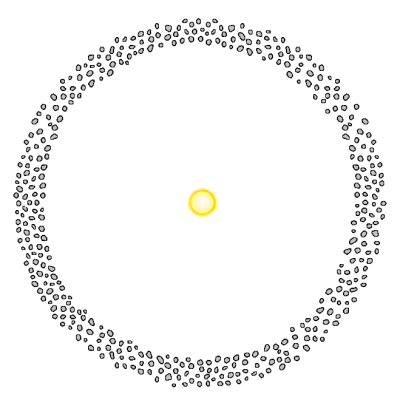Planetoid Belt World
Jump to navigation
Jump to search
A Planetoid Belt World is an asteroid belt is a circumstellar disc in a system occupied by numerous irregularly shaped bodies called asteroids or minor planets.
- Not a Not a Main World.
- Planet or world type.
Description / Specifications[edit]
Planetary Characteristics[edit]
No information yet available.
| Type | Code | Size | Atm | Hyd | Pop | Gov | Law | Remarks |
|---|---|---|---|---|---|---|---|---|
| Asteroid Belt World | As | 0 | 0 | 0 | -- | -- | -- | Asteroid. Part of belt. MW. |
| Planetoid Belt | None | 0 | 0 | 0 | -- | -- | -- | Planetoid. Part of belt. Non-MW. |
| Vacuum World | Va | 123456789 | 0 | -- | -- | -- | -- | Vacuum. Asteroid or planetoid belt. Usually Co or Fr. |
Probably Planetary Orbit & Climate[edit]
No information yet available.
| TC | Inner (-) | HZ-2 | HZ-1 | HZ | HZ+1 | HZ+2 | Outer (+) | Remote & Far Systems | Remarks |
|---|---|---|---|---|---|---|---|---|---|
| As | Unlikely | Belt | Belt | Unlikely | Belt | Belt | Unlikely | Possible | A belt as a Main World. |
| Va | Unlikely | Likely | Likely | Possible | Likely | Likely | Unlikely | Possible | A world without an atmosphere. |
History & Background (Dossier)[edit]
No information yet available.
Asteroids vs. Planetoids![edit]
Asteroid and Planetoid Belts: The terms asteroid and planetoid are effectively synonymous; they mean small or minor planets. Each term refers to a belt of many similar small planets in orbit around the central star.
- For the purposes of differentiation, the term asteroid refers to such a belt when it is the main world of a system. The term planetoid belt refers to such a group of minor planets when another belt or world is the main world in a system.
- Asteroid and planetoid belts typically hold between 1,000 and 10,000 asteroids or planetoids each. [1]
See also[edit]
Universal world profile[edit]
Expand
§ == ( Please refer to the following AAB Library Data for more information: ) == §
References & Contributors / Sources[edit]
| This article is missing content for one or more detailed sections. Additional details are required to complete the article. You can help the Traveller Wiki by expanding it. |
This list of sources was used by the Traveller Wiki Editorial Team and individual contributors to compose this article. Copyrighted material is used under license from Mongoose Publishing or by permission of the author. The page history lists all of the contributions.
- Marc Miller. Worlds and Adventures (Game Designers Workshop, 1977), .Marc Miller, Robert Eaglestone, Don McKinney. Worlds and Adventures (Far Future Enterprises, 2019), .
- Marc Miller. Scouts (Game Designers Workshop, 1983), .
- T5: Core rules
- External Link: Beowolf's Libary Data Website
- Author & Contributor: Lord (Marquis) and Master of Sophontology Maksim-Smelchak of the Ministry of Science
- ↑ Marc Miller. Scouts (Game Designers Workshop, 1983), 39.
